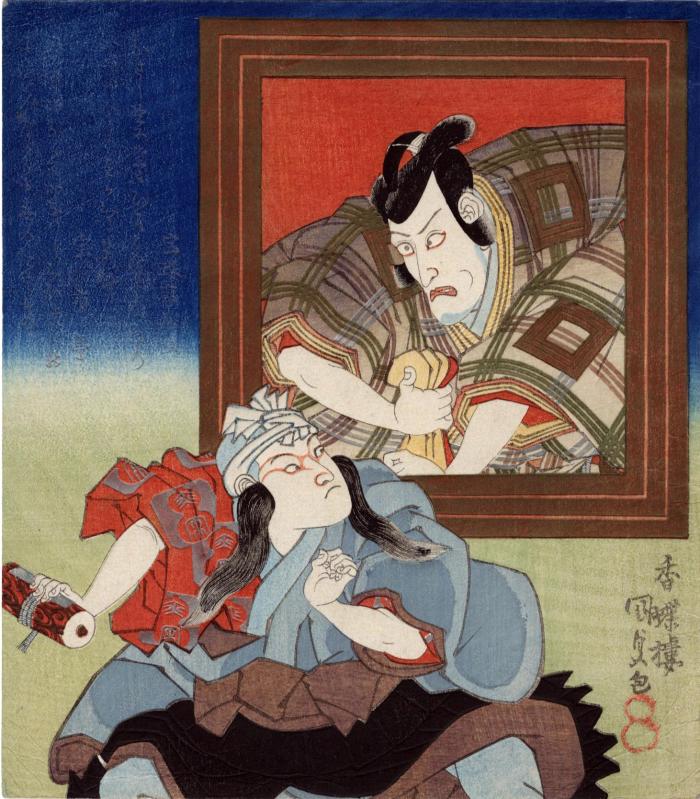Utagawa Kunisada (歌川国貞) / Toyokuni III (三代豊国) (artist 1786 – 01/12/1865)
Ichikawa Ebizō VI as Namazu Bōzu in front of Danjūrō VII's portrait
1830
7.25 in x 8.25 in (Overall dimensions) Japanese woodblock print
Signed: Kōchōrō Kunisada ga
香蝶楼国貞画
Artist's seal: double toshidama in red
Museum of Fine Arts, Boston
Harvard Museums
Achenbach Foundation for Graphic Arts
Rijksmuseum
Lyon Collection - Kunisada fan print with yau seal motif
New York Public Library
Musées Royaux d'Art et d'Histoire (via Ritsumeikan University)
Los Angeles County Museum of Art This fine surimono shows the young actor, Ichikawa Ebizō VI, eight years old at the time, as Namazu Bōzu in front of a portrait of his famous father, Ichikawa Danjūrō VII. This portrait is framed by the mon (crest) of the Ichikawa family. Ebizō VI was a precocious actor who was to commit suicide in 1854 when he was just 30 years old. He succeeded to the name Danjūrō VIII in the third month of 1832 when his father took back the name Ebizô V. This double portrait could have been made on that occasion.
Surimono which mostly had been commissioned by poetry circles on specific occasions, like for the beginning of a new year or on the occasion of anniversaries, but also by other artists like actors on the occasion of name changes (as most likely in this case)- were given as presents to selected people. They were published privately in very small editions of sometimes only 20 impressions.
If you use the zooming tool to enlarge this print you will see that there is a poem, or poems, written - probably in metallic inks - in the dark blue area to the left.
*****
Illustrated:
1) in color - along with a text - in Surimono in the Rijksmuseum, Amsterdam by Matthi Forrer, Hotei Publishing, 2013, p. 291.
2) in a full-page, black and white illustration in volume IV of Japanese Prints in the Rijkmuseum: Hiroshige and the Utagawa School, 1984, no. 146, p. 87. The poems on this copy are by Hōshutei Funauta and Hōshitei (=Masunari). The accompanying text is on page 86.
3) in black and white in The Male Journey in Japanese Prints by Roger Keyes, University of California Press, 1989, fig. 32, p. 16.
4) Jewels of Japanese Printmaking: Surimono of the Bunka-Bunsei Era 1804-1830, by Joan Mirviss, p. 145. On page 144 it says: "The print was probably issued to commemorate the son's role as Kobōzu Donguri, 'the little priest Acorn' in a performance of Ichiyoraifuku Shibuya no tsuwamono at the Kawarazaki Theater in the eleventh month of 1830. The red robe of the youthful actor is adorned with a 'yau' seal-motif; this is an alternative name for many Ichikawa actors and also the name of the family's residence in Fukagawa....
There is another version of this surimono bearing different poems [in the Rijksmuseum]. In this impression, the poems (partially illegible) are by Shunyūtei and Chigusaan."
****
The text on the print reads:
「宝珠亭船唄 むさし野に柴もひそられと春雨のおやのひかりをか(?)る若艸」「宝市亭 そか中になくてかなはしらひつみの子海老なからも春のたてもの」
surimono - 摺物 (genre)
actor prints (yakusha-e - 役者絵) (genre)
Ichikawa Danjūrō VII (七代目市川團十郎: 11/1800 to 2/1832) (actor)
Ichikawa Ebizō VI (六代目市川海老蔵) (actor)
Fukagawa (深川) (genre)
